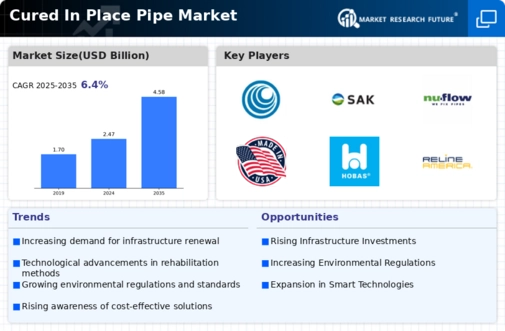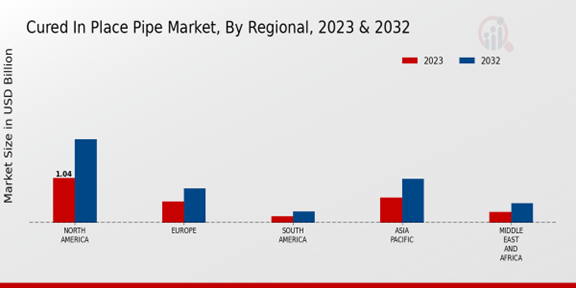Market Growth Projections
The Global Cured In Place Pipe Market Industry is projected to experience substantial growth over the coming years. With a market value of 2.47 USD Billion in 2024, the industry is on a trajectory towards reaching 4.58 USD Billion by 2035. This growth reflects a compound annual growth rate of 5.77% from 2025 to 2035, indicating a robust demand for Cured In Place Pipe solutions. Factors such as increasing infrastructure investments, environmental sustainability initiatives, and technological advancements are likely to contribute to this upward trend. The market's expansion is anticipated to create opportunities for stakeholders across the value chain, from manufacturers to service providers.
Technological Advancements
Technological advancements play a crucial role in the Global Cured In Place Pipe Market Industry. Innovations in materials and curing processes enhance the efficiency and durability of Cured In Place Pipe systems. For example, the development of advanced resin formulations has improved the performance characteristics of these pipes, making them suitable for a wider range of applications. Additionally, the integration of smart technologies for monitoring and maintenance is likely to further drive market growth. As these advancements continue to emerge, they may contribute to a compound annual growth rate of 5.77% from 2025 to 2035, indicating a robust future for the industry.
Regulatory Support and Standards
Regulatory support and the establishment of standards significantly impact the Global Cured In Place Pipe Market Industry. Governments are increasingly recognizing the importance of maintaining infrastructure integrity and are implementing regulations that encourage the use of trenchless technologies. These regulations often mandate the use of environmentally friendly materials and methods, which align with the capabilities of Cured In Place Pipe systems. As compliance with these standards becomes more critical, the market is likely to benefit from increased adoption rates. This regulatory environment fosters innovation and investment in Cured In Place Pipe technologies, potentially leading to a more robust market landscape.
Increasing Infrastructure Investment
The Global Cured In Place Pipe Market Industry is experiencing a surge in demand due to heightened investments in infrastructure. Governments worldwide are allocating substantial budgets for the rehabilitation of aging water and sewer systems. For instance, in 2024, the market is projected to reach 2.47 USD Billion, reflecting a growing recognition of the need for sustainable and efficient pipeline solutions. This trend is likely to continue as municipalities seek to minimize disruptions and enhance service reliability. The adoption of Cured In Place Pipe technology allows for quick repairs without extensive excavation, making it an attractive option for urban areas with dense populations.
Environmental Sustainability Initiatives
The Global Cured In Place Pipe Market Industry is increasingly influenced by environmental sustainability initiatives. As governments and organizations prioritize eco-friendly practices, the demand for trenchless technologies like Cured In Place Pipe is likely to rise. This method reduces the carbon footprint associated with traditional excavation and pipe replacement. Moreover, the ability to rehabilitate existing pipelines without generating significant waste aligns with global sustainability goals. As cities aim to reduce their environmental impact, the Cured In Place Pipe technology appears to be a viable solution, potentially contributing to the market's growth towards an estimated 4.58 USD Billion by 2035.
Growing Urbanization and Population Density
The Global Cured In Place Pipe Market Industry is poised for growth due to rising urbanization and population density. As urban areas expand, the demand for efficient and effective pipeline solutions becomes paramount. Cured In Place Pipe technology offers a means to address the challenges posed by aging infrastructure in densely populated regions. The ability to rehabilitate existing pipelines with minimal disruption is particularly appealing to city planners and utility managers. This trend is expected to drive the market towards a valuation of 4.58 USD Billion by 2035, as urban centers increasingly adopt innovative solutions to manage their infrastructure needs.



 Source: Primary Research, Secondary Research, Market Research Future Database and Analyst Review
Source: Primary Research, Secondary Research, Market Research Future Database and Analyst Review

















Leave a Comment